
Professor Mónika López-Anuarbe lends her expertise to Connecticut’s COVID-19 vaccine rollout
As Connecticut undertakes the largest, fastest vaccine rollout in history, Associate Professor of Economics Mónika López-Anuarbe is serving on multiple state committees to help make the process as equitable as possible for vulnerable communities.
A health and inequality economist who specializes in aging, caregiving and health-care disparities, López-Anuarbe first joined the Connecticut Conference of Independent Colleges working group on higher education support. She was then asked to join the state’s Division of Emergency Management and Homeland Security committee as a member of the Emergency Support Function Vaccination Messaging Subcommittee. The ESF subcommittee will soon join forces with the state’s Diverse Communities Outreach Task Force.
“I’m very interested in community outreach for vulnerable populations,” said López-Anuarbe, who also serves as the coordinator for Conn's Public Health Pathway. “This is all unprecedented. In the history of our nation, we have never encountered such a massive vaccination rollout. In any given year, we vaccinate 30 to 40 million people. And now we are trying to vaccinate 330 million people—and some of them twice, if they are taking the two-dose vaccine.”
Working with the Connecticut Department of Health and FEMA, the Federal Emergency Management Agency, the committees have been helping to establish vaccine priority groups; address equity issues within the rollout plan; and distribute information about the vaccines and how, when and where to get one.
“We created a lot of very simple brochures with direct information. People get drowned in information; they don’t know what to look for and where to look for it. We created one pagers and kept it simple,” López-Anuarbe said.
Originally, Connecticut’s vaccination plan was based on priority groups of frontline workers and those with underlying health conditions. But in late February, Connecticut Governor Ned Lamont announced that the state would shift to an age-based rollout plan.
That shift simplifies the process significantly, López-Anuarbe said, but groups like hers are continuing to work on issues of equity and access.
“The guidelines before the age groups were really complicated—you almost had to draw a tree to understand if you qualified or not,” she said. “But most people know how old they are, so in that sense, it increases access because people know if they are eligible.”
López-Anuarbe added that while many communities of color have higher rates of underlying health conditions that may have qualified them for a vaccine sooner under the original plan, many also lack access to health care and may not have been able to prove eligibility.
“If you are already in a marginalized group that doesn’t get health care, you might not have been diagnosed with a qualifying preexisting condition to begin with. So, you might be sick, but you don’t have a note that says you are sick. For that reason, I like the fact that it’s age-based. But, of course, that’s not enough, that can’t be the only parameter.”
To further address issues of access and equity, the state is now looking to prioritize certain geographical areas, taking into account the social vulnerability index scores of various cities and neighborhoods.
“I appreciate our ability to be flexible,” López-Anuarbe said. “The age groups simplified a lot of problems, and now we are adding the zip code priority to help address inequities.”
While there have certainly been hiccups, López-Anuarbe said she’s proud of what Connecticut has been able to accomplish, already administering more than 1 million vaccines to its 3.5 million residents. And she’s encouraged by the fact that more than 2 million Americans are now being vaccinated each day nationwide.
“That’s just absolutely unprecedented,” she said.
In the future, López-Anuarbe hopes to see a greater investment in public health. That will put the U.S. in a better position to address the next pandemic, she said, and will lead to better overall health outcomes for Americans.
“If you look at how much we invest in our health care, the U.S. is the No. 1 spender. Our health care economy is $4 trillion and we spend more per capita than any other country, but our health outcomes are not so great. Out of those $4 trillion dollars, we only invest 2% on public health,” she said.
“I’m hoping we can be more proactive. I don’t want history to repeat itself.”

